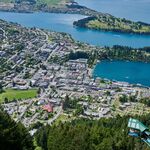SaugeenJunction
Senior Member
Was at Sloane/Eglinton for a while around noon, no trains testing. The green track is also getting really overgrown, they need to cut it.
TTC bosses presumably didn’t have access to a time machine like yours did.My boss at work used to say he wanted things done "yesterday". I don't think TTC bosses are familiar with that expression.
I don’t think China would care for another round of how their countrymen built the Canadian railroads.Yeah good idea! Maybe get China involved into building here!
Deustche Bahn seems to have much troubles of its own lately. Their CEO was fired a few weeks ago.I don’t think China would care for another round of how their countrymen built the Canadian railroads.
Even setting aside the grim historical comparator, if we can’t manage having Deutsche Bahn run GO trains, we’re not building transit using contemporary Chinese norms
Deutsche Bahn’s woes run deep. Trains are delayed or cancelled, bridges are crumbling and public frustration is mounting. How did it come to this?
The narrative put forward by DB and politicians is that somehow, the country’s rail infrastructure fell into disrepair overnight. No one can explain how it happened, and frankly, nobody seems keen to find out.
In truth, soaring traffic has overwhelmed an ageing network while workforce planning has failed, leaving shortages in drivers, controllers and technicians.
At key hubs such as Köln or Frankfurt, even a minor disruption now triggers delays across the entire network.
Meanwhile, management has become bloated yet oddly absent when problems arise. There are plenty of people in charge – just never the right ones when something goes wrong.
Deustche Bahn seems to have much troubles of its own lately. Their CEO was fired a few weeks ago.
This all sounds very familiar, doesn't it?
Germany’s train chaos: How did Deutsche Bahn go off the rails? - Monocle
Germany’s railways are in crisis. Trains run late, tracks crumble and management looks away. Rail expert Christian Böttger explains how...monocle.com
Ding ding ding.It is true that they need to sort out their own mess, before we can ask them to fix ours.
That said, their rail is still a lot more usable than our rail. Over there, the locals are annoyed when their train is late or cancelled; they remember the times when everything was much more reliable. But if you are a tourist or a business visitor, you can still use DB for a lot of trips. Just add more padding to your schedule.
Over here? A lot of places have no train service at all, or no train connection you need. Even if you are lucky to have a train that connects your origin and destination, those trains are so rare they hardly fit anyone's schedule. Unless you are commuting for work to/from Toronto downtown (then you have a half-decent frequency on some of the lines) or travelling within the Corridor, you can't really use our trains for pretty much anything, even if they run perfectly on time.
The problem with ML isn't because they have problems but they are not willing to overhaul the working cultural within the system. DB wanted to convert GO into a subway like system with frequent service probably on EMUs instead of the current locomotive trailer system. ML seems to want to keep the current equipment in place with new electric or hydrogen locomotives and continue the current "commuter" style scheduling on a maximum best frequency of 15 min.Ding ding ding.
No transit system is perfect.
I hear pll in singapore, the netherlands, paris, Tokyo etc. Complain all the damn time. So yea if you're interested in hiring expertise from only perfect systems in this world you'll be looking for a ling time.
Ontarios problem atm isn’t creating perfection, its creating a good system..
db is perfectly suitable for that, if given the right tools and time. Anyway. There's no point in rehashing this subject. Metrolinx is moving on and nothing we say or do is going to turn back the clocks on that decision.
Not to further derail the thread, but I've been wondering lately if the oldies at ML were balking at the massive labour and station overhauls that would need to happen over a short time period. The only way to affordably get to the level of service DB wanted is to have less staff on the trains, the only way to get less staff on the trains is to commit to a level boarding strategy, and the only way to commit to a level boarding strategy is to overhaul every station to bring everything level to the accessibility platform. It's a tough pill to swallow for an organization that is very conservative in its strategy. Refurbishing stations already takes years, I can only imagine the contractor drama it would take to get every station on say Lakeshore East/West to that level and the labour conundrum of transitioning many customer service ambassadors into conductors/engineers.The problem with ML isn't because they have problems but they are not willing to overhaul the working cultural within the system. DB wanted to convert GO into a subway like system with frequent service probably on EMUs instead of the current locomotive trailer system. ML seems to want to keep the current equipment in place with new electric or hydrogen locomotives and continue the current "commuter" style scheduling on a maximum best frequency of 15 min.
Personally I think there is so much the current setup can handle. You can't improve ridership if you constantly prefer to have hundreds of riders flood out a station all queued up every 15 min. The current coaches are nice and comfy but they really restrict customer flow. The lack of doors and standing space makes them not suitable for a metro-like system. Finally if they continue with the current commuter parking lot and making terrible long walks in non-weather protected environments, it will never integrate into the local network. Nothing is pointing to them willing to make these changes.
Let's take Weston GO. If they want to integrate this station and make it easy to commute from Etobicoke to downtown, they would need to run much more frequent (shorter) trains every 5-10 min for most of the day in both directions, not 15-30min. They should convert parts of the parking lot to bus loop allowing the 52, 89 and new routes connecting GO station walkway. Riders could walk from TTC bus stops to the GO platform within less than a minute. With frequent trains, they could connect to Line 5 within 10-15 min of getting off the bus.
We can only hope ML wakes up.
Level boarding is already in GO Transit's long-term plan. Much of the station refurbishment projects they have been doing the past 10 years has been integrating the ability to raise the platforms in the future. DB and Alstom already had a plan on how they were going to handle the labour shake-up since there was already going to be a need for a training program with the new bi-mode and electric locomotives they were going to be getting with the expansion program. The construction and infrastructure partners were already planning all the work they were going to do to get the system to where it would need to be for the plan. My best guess was that someone high up in the PC Government was unwilling to shell out the money that would be needed to move forward with the expansion plans at the pace the ONExpress partnership proposed to move at and so they ordered that plan scrapped in favour of a slower pace of expansion that would cost less in the short term (but ultimately more in the long term). IMO it was a short-sighted decision as everyone knows that GO needs to expand rapidly to help alleviate the congestion problems plaguing the GTHA. Ultimately, this is yet another example of why politicians need to get out of the way of transit planning and growth management because they make short-sighted decisions like this. Especially considering if it was about the cost of the plan, they could have asked the Feds to kick in some cash to alleviate the budget pressures as the federal Libs have been more than willing to support large projects of this scale.Not to further derail the thread, but I've been wondering lately if the oldies at ML were balking at the massive labour and station overhauls that would need to happen over a short time period. The only way to affordably get to the level of service DB wanted is to have less staff on the trains, the only way to get less staff on the trains is to commit to a level boarding strategy, and the only way to commit to a level boarding strategy is to overhaul every station to bring everything level to the accessibility platform. It's a tough pill to swallow for an organization that is very conservative in its strategy. Refurbishing stations already takes years, I can only imagine the contractor drama it would take to get every station on say Lakeshore East/West to that level and the labour conundrum of transitioning many customer service ambassadors into conductors/engineers.
My best guess was that someone high up in the PC Government was unwilling to shell out the money that would be needed to move forward with the expansion plans at the pace the ONExpress partnership proposed to move at and so they ordered that plan scrapped in favour of a slower pace of expansion that would cost less in the short term
No, the parallel would be if SNCF started to suggest and plan for things that were anywhere from against the regulations to downright dangerous. That's why ONxpress was booted from the operations side of the contract.IMO, it would be like ALTO unilaterally deciding to remove sncf from the highspeed project, 4 years into the project, because they dont like their management etc., replace them with a new project lead, descope the project, and all this without really telling the public about the massive changes and to do so without the ministers sign off. A bunch of heads would roll...




